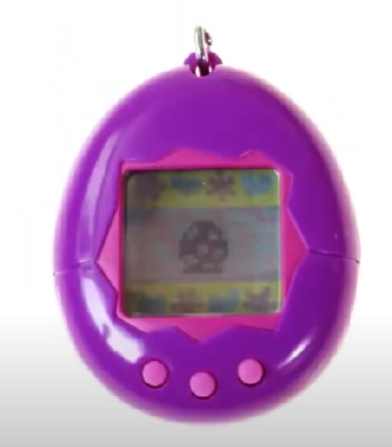Tamagotchi are Back???

- This week please search for a media artifact to deconstruct that is meaningful to you.
I wanted to examine an ad for a toy using the questions below because they seemed more applicable to the elementary level. I have examined ads with students as young as kindergarten age and find it is important to challenge them to think on a deeper level. They get so excited about the ad and the product and do not think about why they experience those emotions or how advertisers might be manipulating them. However, they can grasp and think critically about these things when guided. The questions below give that guidance in a supportive way.
2. Is this message trying to sell a product, an idea, or value?
This message is an advertisement for Tamagotchi digital pets, something I was surprised to hear my daughter say is having a resurgence in popularity amongst her friends. I found the ad interesting because it definitely plays up and uses the controversy caused by the toys when they originally hit the US market in 1997. One of the first catch phrases it uses is “Banned from Schools” and then it immediately moves into fashion oriented aspects such as “Worn” and “Adorn”. The messages are a mix of nostalgia, rebelling against authority and inclusion in pop culture, so it combines selling the product with selling ideas and values.
Why does this advertisement/message work on a cultural level?
On a cultural level, this advertisement is interesting because it appeals to both tweens/preteens and their parents. It stirs up nostalgia and the idea of “stick it to the man” for parents encouraging them to buy them for their kids (and maybe themselves) all while telling kids that they are cool to wear and play with.
What is the story that this advertisement/message tells us about how we should behave?
The story in this ad is interesting. I think it speaks to adults' perceived sense of injustice at rules they found unfair in middle and highschool. It also speaks to the resurgence of 90’s style fashion and cultural icons. The main message is that we can share experiences cross-generationally by buying this toy. It also speaks to the rebel in us all and encourages the toys purchase as a statement in defiance of rules of the past.
What is this advertisement or message telling us about what it means to be happy?
Happiness can be found in shared cultural experience across generations according to Bandai, the makers of Tamagochi. The ad also conveys that fun and fashion can be mixed and virtual pets bring entertainment and happiness.
What does this advertisement convey that people want?
This advertisement conveys that kids want to connect to the past and experience the same fervor and cultural experience that their parents had at their age. They also want to care for something and have it depend on them. A virtual pet is something that can be all their own and is dependent on them, which gives them a sense of adult responsibility. Also, it is something to connect with and share with friends all while looking cute and grabbing attention.
3. Describe how you might, or might not, be able to use these questions/framework below in your final project.
I cannot really use these questions in my final project because it focuses more on research evaluation and use. However, I can use them with my current Digital Citizenship lessons to deepen students’ thoughts about advertising and the effect it has on them and society. The questions would help students think critically about not only ads, but also the products they purchase and their reasons for purchasing them. I like the way they direct students to think about society as a whole and the influence media and, especially, advertising has on the way we view our world and the purchases we make.